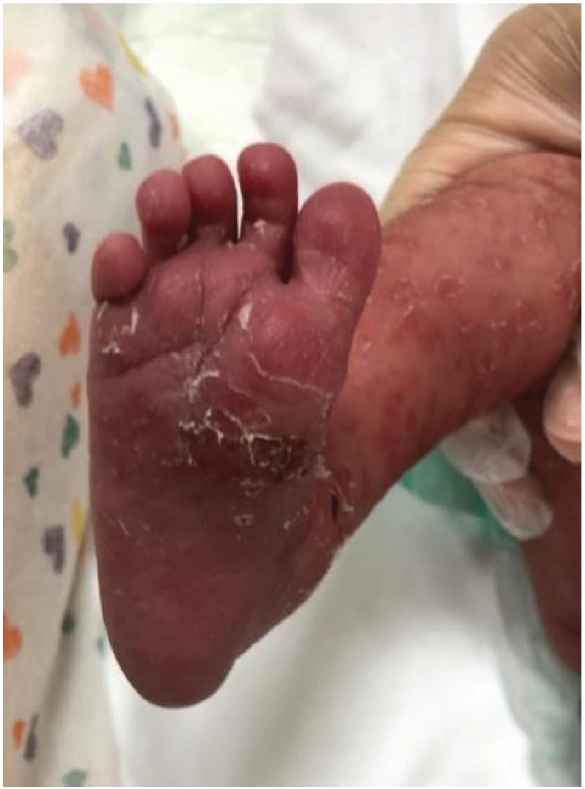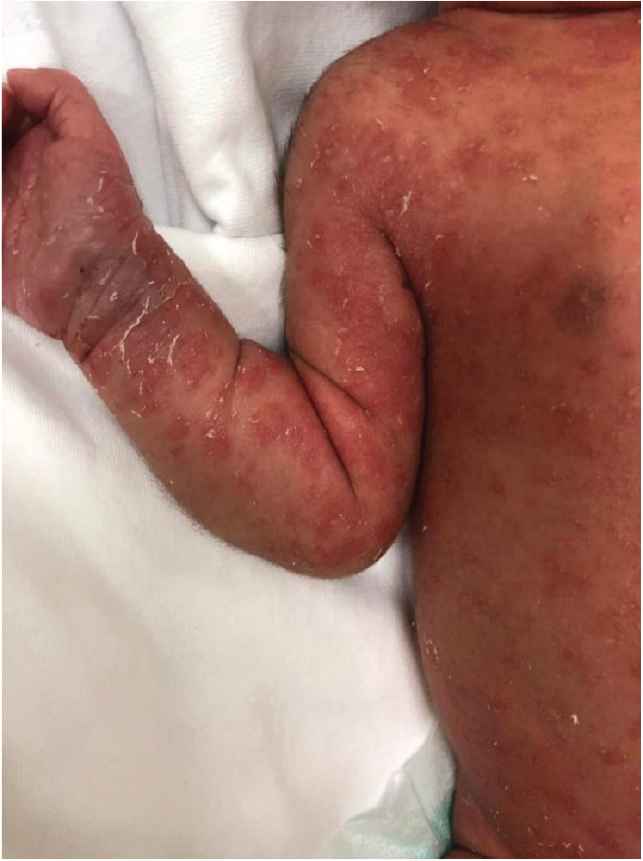Congenital Candidiasis in a Preterm Neonate: Raising Awareness of a Rare and Unpredictable Disease
- DOI
- 10.2991/dsahmj.k.211112.001How to use a DOI?
- Keywords
- Cutaneous candidiasis; preterm; neonates; skin rashes
- Abstract
Congenital cutaneous candidiasis is a rare disease that is usually misdiagnosed as a type of benign neonatal eruption. We report on a preterm infant born with diffuse skin rashes that evolved into various forms and misleading the diagnosis. The persistence of respiratory distress and worsening of chest X-ray findings should alert the physician to systemic involvement. A high index of suspicion and prompt systemic treatment can improve survival rates.
- Copyright
- © 2021 Dr. Sulaiman Al Habib Medical Group. Publishing services by Atlantis Press International B.V.
- Open Access
- This is an open access article distributed under the CC BY-NC 4.0 license (http://creativecommons.org/licenses/by-nc/4.0/).
1. INTRODUCTION
Congenital Candidiasis (CC) can be seen within the 1st week of life as a mucocutaneous infection [1]. It can present as diffuse rashes that prompt systemic antifungal treatment to prevent dissemination and candida-related mortality [2]. The disease indicates intrauterine infection if present at birth [3]. It can easily be mistaken for other benign neonatal skin eruptions, especially if the mother has a normal vaginal culture or has been adequately treated for fungal infections. We report a case of cutaneous CC in a preterm infant who presented with rashes at birth and was misdiagnosed as having benign neonatal eruptions. Few cases have been reported in preterm infants, and of these cases, none have been in Saudi Arabia. Therefore, the awareness of these unusual presentations in neonates with skin rashes is crucial to improving patient care.
2. CASE DESCRIPTION
A preterm boy at a gestational age of 34 weeks and weighing 2540 g was born by spontaneous vaginal delivery to a multigravida mother. No prolonged rupture of membranes occurred. The mother had been treated for vaginal candidiasis 2 years prior to pregnancy. Her high vaginal swab was negative twice for fungal infection at the delivery time. The Apgar scores were 6 and 9 at 1 and 5 min, respectively. The neonate was admitted to the intensive care unit with typical signs of respiratory distress of prematurity. The chest X-ray scan showed a picture of hyaline membrane disease. Ventilation was maintained by continuous positive airway pressure, and the infant was started on appropriate antibiotics after blood culture according to hospital protocol. His skin showed maculopapular eruptions that were more prominent on the abdomen, back, diaper area, and extremities (Figure 1).

Trunk eruptions.
The palms and soles were also affected later on (Figures 2 and 3). The mucous membranes, nails, face, scalp, and placenta were spared.

Sole eruption.

Extremity and palm eruptions.
Initially, the eruption was considered a benign cutaneous eruption, and monitoring of the rashes was planned. The patient’s total leukocyte count was 33 × 109 cells/L, with 57% polymorph nuclear leucocytes, 30% lymphocytes, and a normal platelet count and C-reactive protein level. Despite isolation and appropriate respiratory support, the infant’s condition deteriorated 3 days later. Escalation of ventilation was required and the skin rash became a more erythematous pustular rash with desquamation. No improvement was noted on the empirical antibiotic, and negative blood, urine, and cerebrospinal fluid culture were observed. The repeated chest X-ray showed diffuse bilateral opacification. The patient tested negative on the TORCH screen. On the background of maternal candidiasis in the previous pregnancy, an opinion was sought from the infectious diseases department, and antifungals were advised after scraping the rashes for culture. Intravenous amphotericin B and topical miconazole were started. The skin results came back positive for fungal “yeast” after 7 days of incubation. Echocardiography showed a normal heart structure and no evidence of vegetation. An abdominal organ ultrasound and retinal examination revealed no pathology.
The neonate demonstrated improved ventilation and stabilization of vital signs with 3 days of antifungal treatment. A few days later, he became capable of being weaned with respiratory support. The blood and inflammatory markers started to settle. Intravenous amphotericin B and topical miconazole were completed after 14 days. The patient was released in good condition after healing of his skin condition and normalization of vital signs.
3. DISCUSSION
There are few reports of CC in preterm infants, and none have been published in Saudi Arabia. In this report, we have described a case of CC in a preterm infant to stress the importance of awareness of such a disease in the differential diagnosis of neonatal skin eruptions. Our patient presented with respiratory distress syndrome and skin rashes at birth. Because of the rarity of cutaneous candidiasis in the neonatal period, sepsis was first excluded. The skin scraping test showed a fungal infection.
Various issues have been described in the literature as risk factors, such as amniotic fluid leaking, intrauterine instrumentation, maternal cerclage, and untreated vaginal candidiasis [4]. In the present case, none of these factors were reported. Similarly, Dvorak and Gavaller [5] described CC in an infant born by cesarean section without premature rupture of the membrane or any obvious risk factors. Generalized skin rashes are usually detected at or within the first few days of birth. The earlier they appear, the more indicative they are of intrauterine infections, which could explain the cause of premature delivery [3], as in our case. The skin rashes can start as red macular rashes that evolve into papulovesicular and pustular stages all over the body. Our patient showed this skin presentation, but the palm and sole were spared in the first few days, making the diagnosis look like other benign neonatal eruptions [6]. Sending anaerobic skin culture will identify Candida or yeast as well as bacterial etiologies such as Staphylococcus species, which can have similar presentations.
The pathogenesis of CC is not fully understood. Nail involvement and dystrophies were reported in another case [7], but these were not seen in our case. The clinical presentation in neonates is reasonably nonspecific and is not easily distinguished from other causes of sepsis. Signs of systemic dissemination are respiratory distress, heart vegetation, deranged liver enzymes, eye involvements, and positive fluid cultures. Worsening of chest infiltration observed in hyaline membrane disease could be a part of CC in preterm infants, as it was in our case [3]. Because of worsening respiratory symptoms and high white blood cells, our patient was considered to have systemic involvement, and he was treated with amphotericin B in addition to local antifungal preparations. For cutaneous CC the presence of the diffuse rash alone covering more than one skin area indicates an invasive fungal infection and requires systemic treatment [2]. There have been no controlled clinical trials to determine the optimal length of therapy. However, systemic therapy (enteral or intravenous) must be used for a minimum of 14–21 days to prevent dissemination and mortality [2]. Given the rarity of the disease, it is usually not considered in the initial differential diagnosis, which will delay patient recovery. Early recognition of the disease and prompt systemic antifungal therapy are associated with improved survival and outcomes.
4. CONCLUSION
This report highlights that newborn could have CC without obvious risk factors such as premature rupture of membrane or positive maternal vaginal swab, and it could be misdiagnosed as benign skin eruption. Worsening of respiratory symptoms on top of the skin rashes are potential presentation. Therefore, it is crucial to include CC screening as a part of unexplained skin rashes in neonates. Early diagnosis and treatment could reduce morbidity and prevent further complications.
CONFLICTS OF INTEREST
The authors have no conflicts of interest to declare. All co-authors have seen and agree with the contents of the manuscript and there is no financial interest to report.
AUTHORS’ CONTRIBUTION
Rami Abuhajj, BS, Rasha Abdulla, MA and AAZ contributed in conceptualization, review and editing the manuscript. BS contributed in data collection. MA contributed in writing the original draft. AAZ supervised the project. However, all the authors review the manuscript and approve the final draft.
FUNDING
No financial support was provided.
Footnotes
REFERENCES
Cite this article
TY - JOUR AU - Rami Abuhajj AU - Mohamed Abdoun AU - Baneen Syeda AU - Rasha Abdulla AU - Abdulrahman Al Zahrani PY - 2021 DA - 2021/11/20 TI - Congenital Candidiasis in a Preterm Neonate: Raising Awareness of a Rare and Unpredictable Disease JO - Dr. Sulaiman Al Habib Medical Journal SP - 144 EP - 146 VL - 3 IS - 4 SN - 2590-3349 UR - https://doi.org/10.2991/dsahmj.k.211112.001 DO - 10.2991/dsahmj.k.211112.001 ID - Abuhajj2021 ER -
